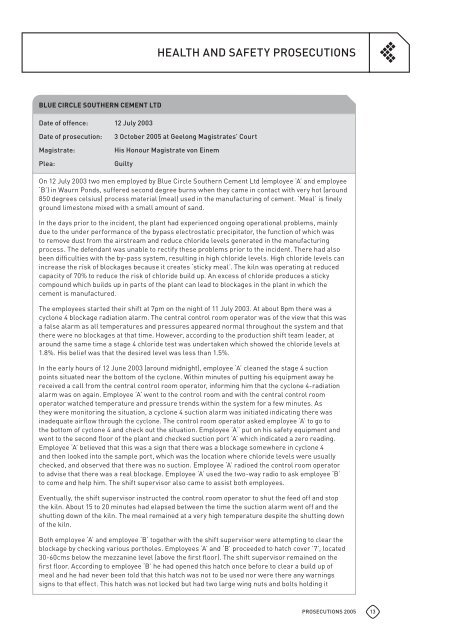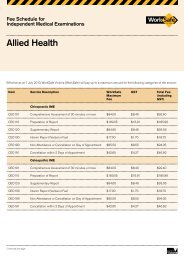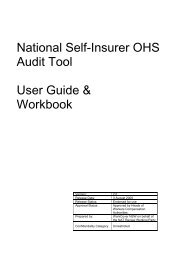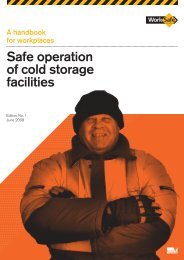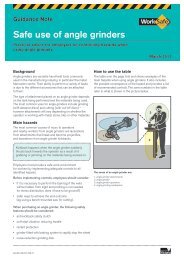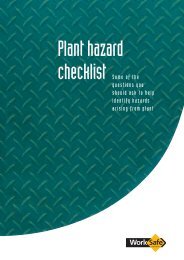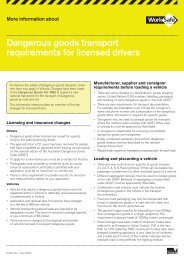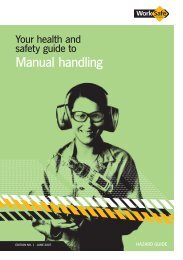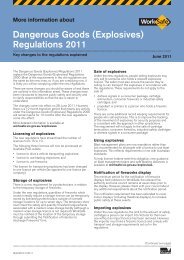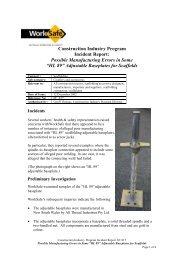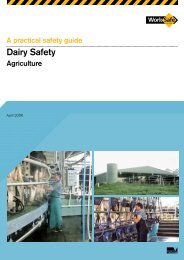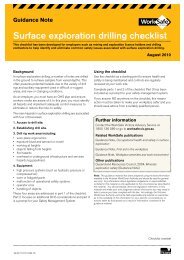Prosecutions 2005 (PDF 3269kb) - WorkSafe Victoria
Prosecutions 2005 (PDF 3269kb) - WorkSafe Victoria
Prosecutions 2005 (PDF 3269kb) - WorkSafe Victoria
You also want an ePaper? Increase the reach of your titles
YUMPU automatically turns print PDFs into web optimized ePapers that Google loves.
HEALTH AND SAFETY PROSECUTIONS<br />
BLUE CIRCLE SOUTHERN CEMENT LTD<br />
Date of offence: 12 July 2003<br />
Date of prosecution:<br />
Magistrate:<br />
Plea:<br />
3 October <strong>2005</strong> at Geelong Magistrates’ Court<br />
His Honour Magistrate von Einem<br />
Guilty<br />
On 12 July 2003 two men employed by Blue Circle Southern Cement Ltd (employee ‘A’ and employee<br />
‘B’) in Waurn Ponds, suffered second degree burns when they came in contact with very hot (around<br />
850 degrees celsius) process material (meal) used in the manufacturing of cement. ‘Meal’ is finely<br />
ground limestone mixed with a small amount of sand.<br />
In the days prior to the incident, the plant had experienced ongoing operational problems, mainly<br />
due to the under performance of the bypass electrostatic precipitator, the function of which was<br />
to remove dust from the airstream and reduce chloride levels generated in the manufacturing<br />
process. The defendant was unable to rectify these problems prior to the incident. There had also<br />
been difficulties with the by-pass system, resulting in high chloride levels. High chloride levels can<br />
increase the risk of blockages because it creates ‘sticky meal’. The kiln was operating at reduced<br />
capacity of 70% to reduce the risk of chloride build up. An excess of chloride produces a sticky<br />
compound which builds up in parts of the plant can lead to blockages in the plant in which the<br />
cement is manufactured.<br />
The employees started their shift at 7pm on the night of 11 July 2003. At about 8pm there was a<br />
cyclone 4 blockage radiation alarm. The central control room operator was of the view that this was<br />
a false alarm as all temperatures and pressures appeared normal throughout the system and that<br />
there were no blockages at that time. However, according to the production shift team leader, at<br />
around the same time a stage 4 chloride test was undertaken which showed the chloride levels at<br />
1.8%. His belief was that the desired level was less than 1.5%.<br />
In the early hours of 12 June 2003 (around midnight), employee ‘A’ cleaned the stage 4 suction<br />
points situated near the bottom of the cyclone. Within minutes of putting his equipment away he<br />
received a call from the central control room operator, informing him that the cyclone 4-radiation<br />
alarm was on again. Employee ‘A’ went to the control room and with the central control room<br />
operator watched temperature and pressure trends within the system for a few minutes. As<br />
they were monitoring the situation, a cyclone 4 suction alarm was initiated indicating there was<br />
inadequate airflow through the cyclone. The control room operator asked employee ‘A’ to go to<br />
the bottom of cyclone 4 and check out the situation. Employee ‘A’’ put on his safety equipment and<br />
went to the second floor of the plant and checked suction port ‘A’ which indicated a zero reading.<br />
Employee ‘A’ believed that this was a sign that there was a blockage somewhere in cyclone 4<br />
and then looked into the sample port, which was the location where chloride levels were usually<br />
checked, and observed that there was no suction. Employee ‘A’ radioed the control room operator<br />
to advise that there was a real blockage. Employee ‘A’ used the two-way radio to ask employee ‘B’<br />
to come and help him. The shift supervisor also came to assist both employees.<br />
Eventually, the shift supervisor instructed the control room operator to shut the feed off and stop<br />
the kiln. About 15 to 20 minutes had elapsed between the time the suction alarm went off and the<br />
shutting down of the kiln. The meal remained at a very high temperature despite the shutting down<br />
of the kiln.<br />
Both employee ‘A’ and employee ‘B’ together with the shift supervisor were attempting to clear the<br />
blockage by checking various portholes. Employees ‘A’ and ‘B’ proceeded to hatch cover ’7’, located<br />
30-60cms below the mezzanine level (above the first floor). The shift supervisor remained on the<br />
first floor. According to employee ‘B’ he had opened this hatch once before to clear a build up of<br />
meal and he had never been told that this hatch was not to be used nor were there any warnings<br />
signs to that effect. This hatch was not locked but had two large wing nuts and bolts holding it<br />
PROSECUTIONS <strong>2005</strong><br />
13


